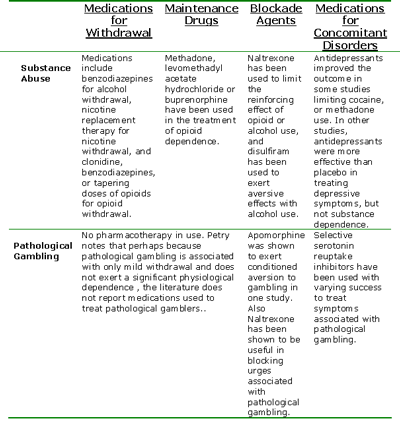The diagnostic criteria for substance dependence are characterized by tolerance, withdrawal, and narrowing of interests to drug seeking and ingestion (American Psychiatric Association, 1994). Pathological gamblers also develop tolerance and need to spend greater sums of money to achieve the same level of excitement as before on lower levels of wagering. Pathological gamblers experience withdrawal symptoms such as restlessness and irritability, and will narrow their range of interests to focus on gambling, at the expense of obligations to family and work (Griffiths, 1993; Lorenz & Yaffee, 1986; Wray & Dickerson, 1981). Petry (2002) considered that the similarities between symptoms of pathological gambling and substance dependence suggest that treatments for substance dependence might benefit pathological gamblers as well. In Table 1, this week’s WAGER summarizes part of a literature review by Petry (2002) on the applicability of four pharmacotherapies to treat both substance dependence and pathological gambling. Specifically we report what Petry found regarding medications used to (1) treat withdrawal symptoms, (2) mimic the effects of the abused substance, (3) limit a person from consuming the substance by blocking positive effects or making the substance use aversive, or (4) treat concomitant psychiatric symptoms.
Table 1. Pharmacotherapy treatments for substance abuse and pathological gambling (Petry, 2002).
Petry concluded, “In sum, much more research is necessary to better understand and treat pathological gambling” (Petry 2002, p. 189). In her review, Petry relies on DSM-IV diagnostic criteria to highlight the similarity between pathological gambling and substance dependence and suggests that these distinct disorders can be treated by similar interventions. If this is true, perhaps these disorders are not so different, and there is a weakness in the diagnostic system. Next, although Petry used substance abuse treatments to indicate potential and related pathological gambling treatments, we might consider how pathological gambling treatments can inform substance abuse treatments. Pathological gambling researchers have conducted innovative studies which might offer new clues to substance abuse researchers. In addition to seeking effective pharmacotherapies among current categories of medications used to treat substance abuse, researchers also should investigate pharmacotherapies that are outside those categories. For example, a recent report (Johnson et al., 2003) indicated that topiramate, a medication with applications for control of seizure disorders, was effective for treating alcohol dependence. Further research may discover similar non-conventional pharmacotherapies for use in pathological gambling.
Comments on this article can be addressed to Michael Stanton at wager@hms.harvard.edu
References
American Psychiatric Association. (1994). DSM-IV: Diagnostic and statistical manual of mental disorders (Fourth ed.). Washington, D.C.: American Psychiatric Association.
Griffiths, M. (1993). Tolerance in gambling: An objective measure using the psychophysiological analysis of male fruit machine gamblers. Addictive Behaviors, 18, 365-372.
Johnson, B. A., Ait-Daoud, N., Bowden, C. L., DiClemente, C. C., Roache, J. D., Lawson, K., Javors, M. A., & Ma, J. Z. (2003). Oral topiramate for treatment of alcohol dependence: a randomised controlled trial. Lancet, 361, 1677-1685.
Lorenz, V. C., & Yaffee, R. A. (1986). Pathological gambling: Psychosomatic, emotional and marital difficulties as reported by the gambler. Journal of Gambling Studies, 2, 40-49. Petry, N. M. (2002). How Treatments for Pathological
Gambling Can Be Informed by Treatments for Substance Use Disorders. Experimental and Clinical Psychopharmacology, 10(3), 1874-1192.
Wray, I., & Dickerson, M. (1981). Cessation of high frequency gambling and "withdrawal" symptoms. British Journal of Addiction, 76, 401-405.





